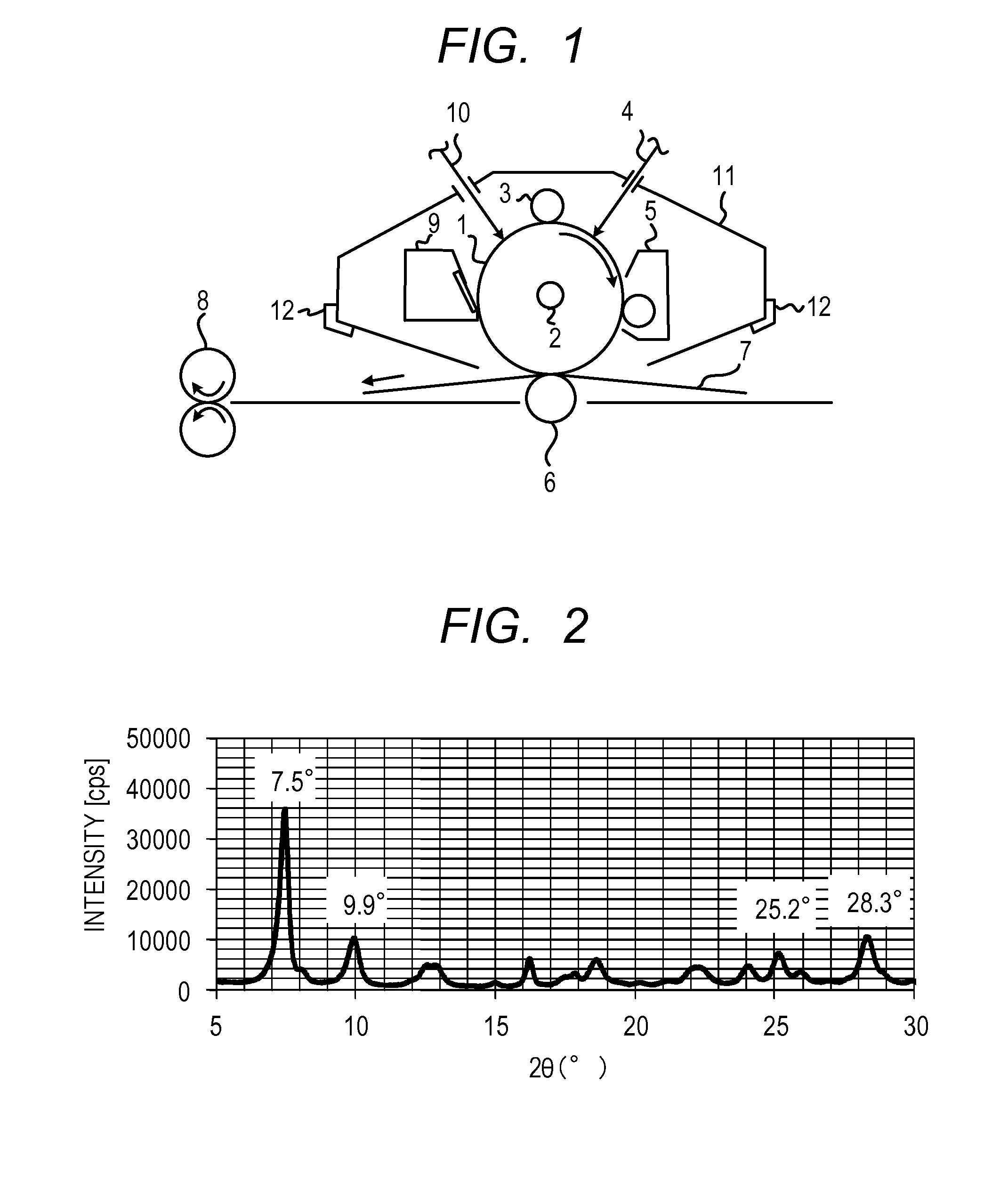Electrophotographic photosensitive member, manufacturing method of electrophotographic photosensitive member, process cartridge and electrophotographic apparatus, and phthalocyanine crystal and manufacturing method of phthalocyanine crystal
a manufacturing method and photosensitive technology, applied in the field of electrophotographic photosensitive members, can solve the problems of potential variation and difficulty in conversion to a desired crystalline form in some cases, and achieve the effect of reducing image defects
- Summary
- Abstract
- Description
- Claims
- Application Information
AI Technical Summary
Benefits of technology
Problems solved by technology
Method used
Image
Examples
example 1-1
[0078]As described below, hydroxygallium phthalocyanine was produced by the same as in Synthesis Example 1 and Example 1-1 described in Japanese Patent Application Laid-Open No. 2011-94101. Under nitrogen flow atmosphere, 5.46 parts of phthalonitrile and 45 parts of α-chloronaphthalene were fed into a reaction tank, then heated up to a temperature of 30° C., and maintained at the temperature. Subsequently, 3.75 parts of gallium trichloride was fed thereto at the temperature (30° C.). At the feeding time, the mixture liquid had a water content of 150 ppm. The temperature was then increased to 200° C. Under the nitrogen flow atmosphere, a reaction was caused at a temperature of 200° C. for 4.5 hours, which was then cooled to a temperature of 150° C. for filtering a product. The produced residue was dispersed and cleaned with N,N-dimethylformamide at a temperature of 140° C. for 2 hours, and then filtrated. The produced residue was cleaned with methanol and dried to produce 4.65 parts ...
example 1-2
[0081]A hydroxygallium phthalocyanine crystal in an amount of 0.42 parts was obtained by the same treatment as in Example 1-1, except that the milling treatment time was changed from 1000 hours to 2000 hours in Example 1-1. The powder X-ray diffraction pattern of the produced crystal was the same as in Example 1-1. The angle and the intensity of the peak emerging at Bragg angle 2θ of 9.9°±0.2°, the intensity on a side 2.8° wider from the peak angle, and the ratio of the intensity are described in Table 1.
[0082]It was confirmed that 0.70% by mass dimethyl sulfoxide is contained relative to phthalocyanine in the phthalocyanine crystal by the NMR measurement.
example 1-3
[0083]A hydroxygallium phthalocyanine crystal in an amount of 0.44 parts was obtained by the same treatment as in Example 1-1, except that the milling treatment time was changed from 1000 hours to 500 hours in Example 1-1. The powder X-ray diffraction pattern of the produced crystal was the same as in Example 1-1. The angle and the intensity of the peak emerging at Bragg angle 2θ of 9.9°±0.2°, the intensity on a side 2.8° wider from the peak angle, and the ratio of the intensity are described in Table 1.
[0084]It was confirmed that 1.25% by mass dimethyl sulfoxide is contained relative to phthalocyanine in the phthalocyanine crystal by the NMR measurement.
PUM
 Login to View More
Login to View More Abstract
Description
Claims
Application Information
 Login to View More
Login to View More - R&D
- Intellectual Property
- Life Sciences
- Materials
- Tech Scout
- Unparalleled Data Quality
- Higher Quality Content
- 60% Fewer Hallucinations
Browse by: Latest US Patents, China's latest patents, Technical Efficacy Thesaurus, Application Domain, Technology Topic, Popular Technical Reports.
© 2025 PatSnap. All rights reserved.Legal|Privacy policy|Modern Slavery Act Transparency Statement|Sitemap|About US| Contact US: help@patsnap.com



